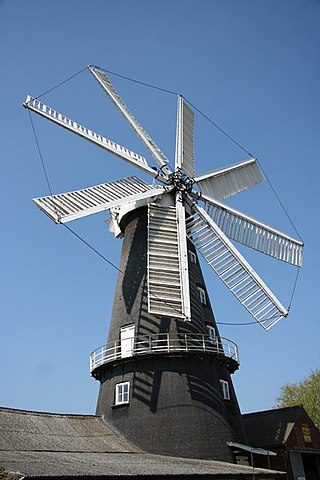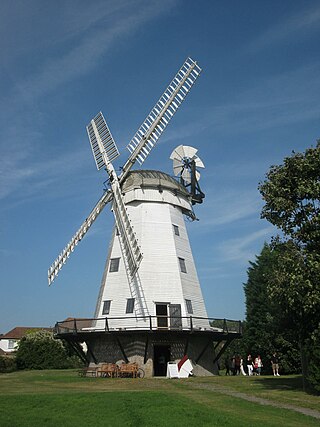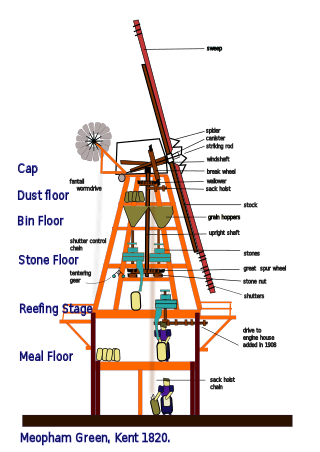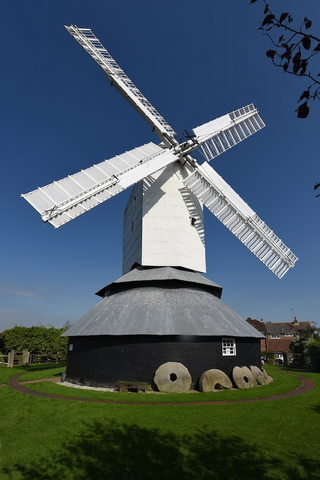This article needs additional citations for verification .(December 2015) |

Mount Pleasant Mill is a windmill north of Kirton in Lindsey on the North Cliff Road in North Lincolnshire in the east of England (Yorkshire and the Humber).
This article needs additional citations for verification .(December 2015) |

Mount Pleasant Mill is a windmill north of Kirton in Lindsey on the North Cliff Road in North Lincolnshire in the east of England (Yorkshire and the Humber).
It was built in 1875 for miller Edric Lansdall as a four-patent-sailed, slightly tapering four-storeyed tarred tower mill with onion-shaped cap and fantail on top of the remaining roundhouse of a previously erected post-mill. The junction between the former roundhouse wall of hand-made bricks and the newly superimposed tower made of machine-moulded bricks is almost indistinguishable. On the second floor, the stone floor, originally three pairs of millstones (two pairs of peak stones (grey stones or greys) and one pair of quartzite (French stone)) were driven, of which only one grey pair remained. This peak stone is cut from rock millstone grit quarried in the Peak District of southwest Yorkshire and northeast Derbyshire, England.
The mill has had a namesake windmill in Stockton-on-Tees, built around 1790 as an 8-storeyed four-sailed stage-windmill of ca. 80 ft height in reverse colours (white painted tower with black onion-shaped cap) and demolished around the late 1920s.
Mount Pleasant Mill worked by wind until 1933 and by a diesel single cylinder Crossley engine until 1973. Fred Banks, who ran it then, also owned Alford Windmill. It is the only windmill in the area beside Heapham Mill with original and unrestored equipment and machinery of the 1920s and 1930s. The original cap with the oak cap frame is still in place. The original windshaft, wallower, upright shaft and great spur wheel are made of cast iron, as are the tooth ring of the wooden brakewheel with its timber clasp arm construction and wooden brake, all installed in the 1930s. A refinement to the mill is the elevator to replace the old sack hoist which worked off the underside of the wallower by a friction ring, and the elevator to feed the first floor bin (3rd floor) for the hurst frame. This is a massive timber frame supporting the transfer gearing and heavy mill stones casings, helping to reduce the vibration of the turning mill stones and their wheels (stone nuts). It is a separate structure inside the mill tower thus reducing the transfer of vibrations and noise into the building itself.
The mill was restored in 1991 and is a commercially working flour mill, making organic flour which is sold to the public. There is a tea room for visitors.
On 29 November 2015 the windmill was severely damaged by high winds, causing two of the sails and the tail-fan to be torn off - some pieces landing 200 yards (180 m) away. The mill was shut for two weeks and is now up and running through the use of electric motors powering the French burr stones and the Derbyshire peaks. Business is continuing as usual producing a range of organic flours and fresh breads using a wood-fired oven. [1]

Heckington Windmill is the only eight-sailed tower windmill still standing in the United Kingdom with its sails intact.

Alford Windmill is a five-sailed windmill in Alford, Lincolnshire and the only surviving windmill out of four. Though the windmill has been restored to working order, it no longer supplies flour for sale.

Upminster Windmill is a Grade II* listed smock mill located in Upminster in the London Borough of Havering, England. It was formerly known as Abraham's Mill and was in Essex when built. Between 2016 and 2023 the mill was restored to working order and a visitor centre was constructed. The mill and visitor centre are open to the public at selected times.

Durrington or High Salvington Windmill is a Grade II listed post mill in High Salvington, Sussex that has been restored and is in full working order. The mill stands 320 feet (98 m) above sea level and is able to take advantage of incoming sea winds.

Outwood Windmill is a Grade I listed post mill in Outwood, Surrey. Built in 1665 by Thomas Budgen, a miller from Nutfield in Surrey, it is Britain's oldest working windmill. It was one of a pair after 1797, alongside a smock mill that had the tallest smock tower in the United Kingdom until its collapse in 1960.

John Webb’s or Lowe’s Mill is a Grade II* listed tower mill at Thaxted, Essex, England, which had been restored to working order, but is currently out of action following the loss of a sail in April 2010.
The Clayton Windmills, known locally as Jack and Jill, stand on the South Downs above the village of Clayton, West Sussex, England. They comprise a post mill and a tower mill, and the roundhouse of a former post mill. All three are Grade II* listed buildings.

Caston Tower Windmill is a grade II* listed tower mill at Caston, Norfolk, England which is under restoration. The mill is also a scheduled monument.

This glossary of mill machinery covers the major pieces of machinery to be found in windmills, watermills and horse mills. It does not cover machinery found in modern factories.

White Mill is a smock mill west of Sandwich, Kent, England that was built in 1760. The mill has been restored and is open to the public as part of the White Mill Rural Heritage Centre. The museum also includes the miller's cottage, which has been furnished to appear as it did between 1900 and 1939. Other displays in the outbuildings include farming and craft tools, wheelwright and blacksmith workshops.
Stanford Windmill is a Grade II* listed tower mill in Stanford, Kent, England that was built in 1857. It stands on Kennett Lane in Stanford.

Windmill Hill Mill is a grade II* listed post mill at Herstmonceux, Sussex, England which has been restored and now operates as a working mill. The mill is open to the public on most Sundays from Easter until October.

Shiremark Mill, also known as Kingsfold Mill or Capel Mill was a listed Smock mill at Capel, Surrey, England, which was burnt down in 1972.

Bocking Windmill or Bocking Churchstreet Windmill is a grade I listed post mill at Bocking, Essex, England which has been restored.

Terling Windmill is a grade II listed Smock mill at Terling, Essex, England, which has been converted to residential use.

Stansted Mountfitchet Windmill is a grade II* listed Tower mill at Stansted Mountfitchet, Essex, England which is also a Scheduled Ancient Monument. It has been restored and can turn by wind.

Thelnetham Windmill, also known as Button's Mill is a Grade II* listed tower mill constructed of brick. The windmill is located at Thelnetham, Suffolk, England. It was built in the early nineteenth century to grind wheat into flour. Thelnetham windmill worked by wind power until 1924, latterly on two sails, after which it became derelict.

Cromer Windmill, restored in four stages between 1967 and 1998, is a Grade II* listed post mill at Cromer, Ardeley, Hertfordshire, England.

Holgate Windmill is a tower mill at Holgate in York, North Yorkshire, England which has been restored to working order.

Garboldisham Mill is a Grade II* listed post mill at Garboldisham, Norfolk, that has been restored.